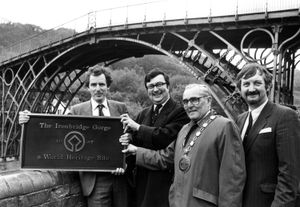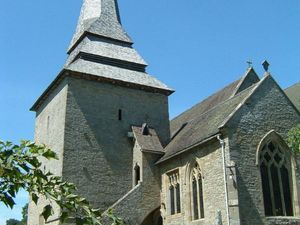The revolution which turned an iron bridge "fit for scrap" into pure gold
Ironbridge Gorge Museums are celebrating 50 years. Toby Neal starts a week of features to mark the milestone.

With a clapped-out iron bridge fit for the scrap merchants and a pile of old bricks as its star exhibits, the award-winning Ironbridge Gorge Museum hasn't done too badly in its 50 years of existence.
Of course, today the Iron Bridge and Abraham Darby's furnace at Coalbrookdale are icons of the Industrial Revolution and attract tourists from around the world.
They have survived and benefited thanks to another, more modern, revolution - a revolution in attitude and the appreciation of industrial history which has seen relics cherished and preserved.
It was a change in sentiment which was crucial in the advent of the museum, which is this year celebrating its golden jubilee, all those years ago.
There is a story that the Iron Bridge was once offered for scrap to a local company, Oakley Arnold of Broseley, so long as they would dismantle it.
It did not happen and Abraham Darby III's masterpiece, dating from 1779 and the first bridge of significant size made of iron anywhere in the world, continues to stand proud across the River Severn to this day.
It is unthinkable now that this centrepiece of the Ironbridge Gorge, which was designated as a World Heritage Site by Unesco 30 years ago because of its global cultural importance, would ever be taken down for no good reason.
As for the Darby furnace, seen by many as the very birthplace of the Industrial Revolution - it was here in 1709 that Abraham Darby I first successfully smelted iron using coke instead of charcoal as a fuel - that too was once in considerable danger and might have been destroyed.
While direct threats have faded, there have however been more subtle threats in modern times. In 1990 there was a public inquiry into a plan by Shropshire County Council to build a brand new bridge at Ladywood, Jackfield, just 400 metres away from the Iron Bridge.
Although it would have been visible from the ancient structure, there was considerable local support for the £1.09 million new bridge, particularly from the Broseley side of the river where the inadequacy of the ferro-concrete Free Bridge at Jackfield to cope with traffic - in the end things were so bad that a prefabricated Bailey bridge was laid on the deck - was keenly felt.
The Government threw out the plans because of the damage the Ladywood bridge would have done to the setting of its illustrious predecessor, which is probably the most photographed structure in Shropshire. In the event a new bridge was built further downstream instead.
A new mood had taken hold in the 1950s when pioneering figures were calling for the relics of the Industrial Revolution which were dotted about the Ironbridge Gorge to be saved, rather than swept away, as had happened, for instance, to the large and striking Benthall Waterwheel, which stood not far from the Iron Bridge, but was scrapped in the 1930s.
They were to lay the groundwork which led in 1967 to a group of visionaries creating the Ironbridge Gorge Museum.
The museum's beginnings were tied in with the enormous changes which were in prospect for the area with the creation of Dawley New Town, as it was then - the concept was expanded as Telford New Town in 1968. Dawley Development Corporation had done a survey of the relics in the early 1960s.
Mike Lowe, who is president of the Ironbridge Gorge Museum Trust, was one of those in at the start in 1967, so this year is also a 50th anniversary for his personal connection with the museum.
"I started off as the honorary auditor and financial adviser to the museum in 1967," said Mike, who has been president since 2002.
"I had trained to be a chartered accountant back in the 1950s. We opened an office in Dawley and decided we should start a chamber of commerce for the new town. We formed Dawley Chamber of Commerce which expanded incredibly rapidly.
"I was invited by Dawley Development Corporation to the very first meeting, which was on Friday, February 3, 1967 - it was a group getting together to talk about creating the museum.
"Dawley Development Corporation's chief designer was John Madin, the sort of person who believed historic things were extremely important."
The upshot of that meeting was that a working party was set up to look at the question of saving "industrial remains" in the new town area.
It comprised Lord Bridgeman, the Lord Lieutenant of the county; consultant planner John Madin; Michael Rix of Birmingham University; Fred Williams, former managing director of Allied Ironfounders Ltd at Ketley; Bruce Ball, former managing director of the Lilleshall Company at Oakengates; and Councillor Isaiah Jones, chairman of Wellington Rural District Council and a member of the development corporation.
Things gathered pace. Major sites identified for inclusion in a projected museum included Coalbrookdale, with its Abraham Darby furnace; Coalport, and its china works; Blists Hill, and the furnaces there; Bedlam Furnaces alongside the River Severn; and last but not least the Iron Bridge itself, along with a number of smaller sites.
On July 25, 1967, the board of the development corporation passed a resolution setting up the Ironbridge Gorge Museum Trust. The news was reported in the Shropshire Star of July 31, which said "The corporation announced today that it had accepted a report from the working party and had agreed to set up a company to be called the Ironbridge Gorge Museum Trust."
It was registered as a limited company in October 1967 and on April 1, 1968, the Ironbridge Gorge Museum Trust was formally founded, under the chairmanship of E. Bruce Ball.
There was that story, which Mike heard years after the event, that in the 1950s the Iron Bridge was ailing.
"The county council consulted a firm in Broseley to ask them what it would cost to take it down, and what they would get for the metal. A lot of people protested. This was in 1952 and I didn't know about it then, but heard about it afterwards."
If this is indeed what happened, there would surely have been immense difficulties in scrapping the bridge, as it had been declared a Scheduled Ancient Monument in 1934 - the first industrial monument to be afforded this special protection.
However, it could be that the idea of scrapping the Iron Bridge may actually have arisen in late Victorian times. According to one account, the county council had discussed the idea "50 years before" the bridge had been scheduled as an ancient monument, which would point to around 1884.
It is however certain that there was talk in the 1950s of building a new bridge in the Ironbridge Gorge, albeit as a replacement for the 1909 Free Bridge at Jackfield. For instance, in July 1954 the Madeley District Committee of Wenlock Borough Council passed a resolution calling on Shropshire County Council to build a new bridge in the Ironbridge Gorge. Broseley District Committee of the borough council joined the call in April 1960 and, on being told the chances of a new bridge were remote, the campaigners turned their attention to trying to get the Free Bridge widened.
While the famous iron bridge may or may not once have been in danger of being scrapped, Abraham Darby's furnace was at least safe when it was described in not-so-glowing terms to one visitor years ago.
The visitor was to have his own part in the museum's story, as its long serving librarian.
Joanne Smith, the museum's registrar, said: "Our former librarian, John Powell, came to visit the site, in the 1970s, I think, to look at the furnace at Coalbrookdale, which in those days did not have the cover building on it.
"He went to go down to the furnace, and the chap who looked after the visitors said: 'Here mate, you don't want to go down there - it's just a pile of old bricks.'"
As for the nascent Ironbridge Gorge Museum of 50 years ago, it was founded on five principles, which at the time were revolutionary.
It would be a charitable trust and would not rely on funding from local or central government.
It would be funded from its visitors, so far as the day-to-day operations were concerned.
A development trust would be established to raise capital and elsewhere for the development of the museum.
It would be based on the local community and a strong supporters group - later to the called The Friends - would be established.
And it would be a museum based on a multiplicity of sites which related to the original industries of the Gorge, rather than being housed in a museum building in the conventional sense.
The new museum embraced a rather motley estate of widely-spread ruins and relics. In the 1960s Blists Hill was still entirely open to the public, which was great for local kids who wanted to play, but not so good for the protection of buildings and artifacts.
One of the earliest acquisitions of the museum was the Quaker burial ground in Coalbrookdale, which was leased to the museum so that it should be maintained.
An exhibition in 1967 had generated considerable interest in the project, and collections started to accumulate.
The museum was on its way and the rest, so to speak, is history.
Over the decades that have followed, the museum team, comprising a mix of key personnel and volunteers, has embraced the spirit of the early pioneers and has built on their work, and they have all played their part in creating an attraction with local, national, and international significance, which has ensured the treasures of the past have not been carelessly lost.
There have been a host of prestigious awards won along the way.
And in the space of 50 years, that "pile of scrap iron" at the heart of the project has been transformed into pure gold.





